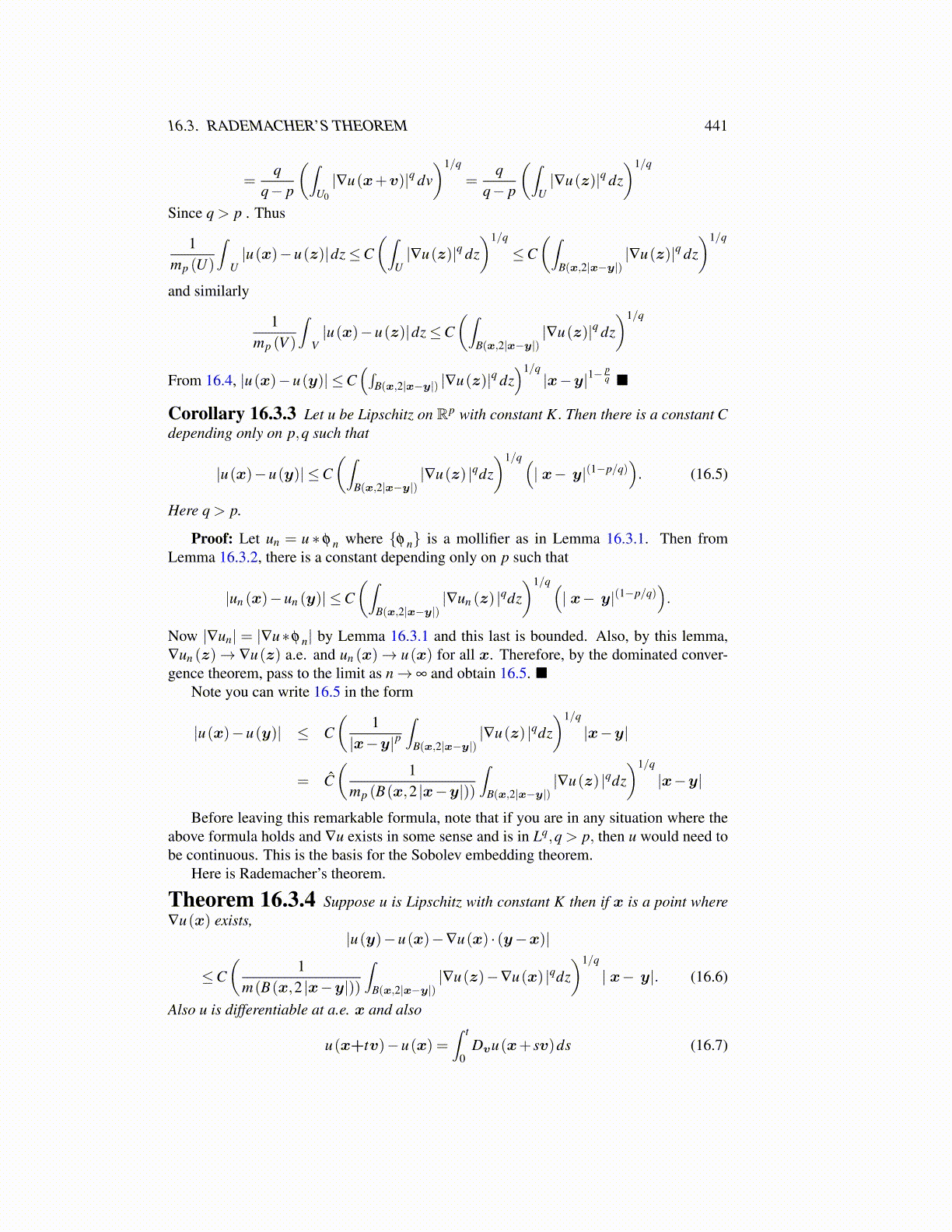
16.3. RADEMACHER’S THEOREM 441
=q
q− p
(∫U0
|∇u(x+v)|q dv)1/q
=q
q− p
(∫U|∇u(z)|q dz
)1/q
Since q > p . Thus
1mp (U)
∫U|u(x)−u(z)|dz≤C
(∫U|∇u(z)|q dz
)1/q
≤C(∫
B(x,2|x−y|)|∇u(z)|q dz
)1/q
and similarly
1mp (V )
∫V|u(x)−u(z)|dz≤C
(∫B(x,2|x−y|)
|∇u(z)|q dz)1/q
From 16.4, |u(x)−u(y)| ≤C(∫
B(x,2|x−y|) |∇u(z)|q dz)1/q|x−y|1−
pq ■
Corollary 16.3.3 Let u be Lipschitz on Rp with constant K. Then there is a constant Cdepending only on p,q such that
|u(x)−u(y)| ≤C(∫
B(x,2|x−y|)|∇u(z) |qdz
)1/q(| x− y|(1−p/q)
). (16.5)
Here q > p.
Proof: Let un = u ∗ φ n where {φ n} is a mollifier as in Lemma 16.3.1. Then fromLemma 16.3.2, there is a constant depending only on p such that
|un (x)−un (y)| ≤C(∫
B(x,2|x−y|)|∇un (z) |qdz
)1/q(| x− y|(1−p/q)
).
Now |∇un| = |∇u∗φ n| by Lemma 16.3.1 and this last is bounded. Also, by this lemma,∇un (z)→ ∇u(z) a.e. and un (x)→ u(x) for all x. Therefore, by the dominated conver-gence theorem, pass to the limit as n→ ∞ and obtain 16.5. ■
Note you can write 16.5 in the form
|u(x)−u(y)| ≤ C(
1|x−y|p
∫B(x,2|x−y|)
|∇u(z) |qdz)1/q
|x−y|
= Ĉ(
1mp (B(x,2 |x−y|))
∫B(x,2|x−y|)
|∇u(z) |qdz)1/q
|x−y|
Before leaving this remarkable formula, note that if you are in any situation where theabove formula holds and ∇u exists in some sense and is in Lq,q > p, then u would need tobe continuous. This is the basis for the Sobolev embedding theorem.
Here is Rademacher’s theorem.
Theorem 16.3.4 Suppose u is Lipschitz with constant K then if x is a point where∇u(x) exists,
|u(y)−u(x)−∇u(x) · (y−x)|
≤C(
1m(B(x,2 |x−y|))
∫B(x,2|x−y|)
|∇u(z)−∇u(x) |qdz)1/q
| x− y|. (16.6)
Also u is differentiable at a.e. x and also
u(x+tv)−u(x) =∫ t
0Dvu(x+ sv)ds (16.7)